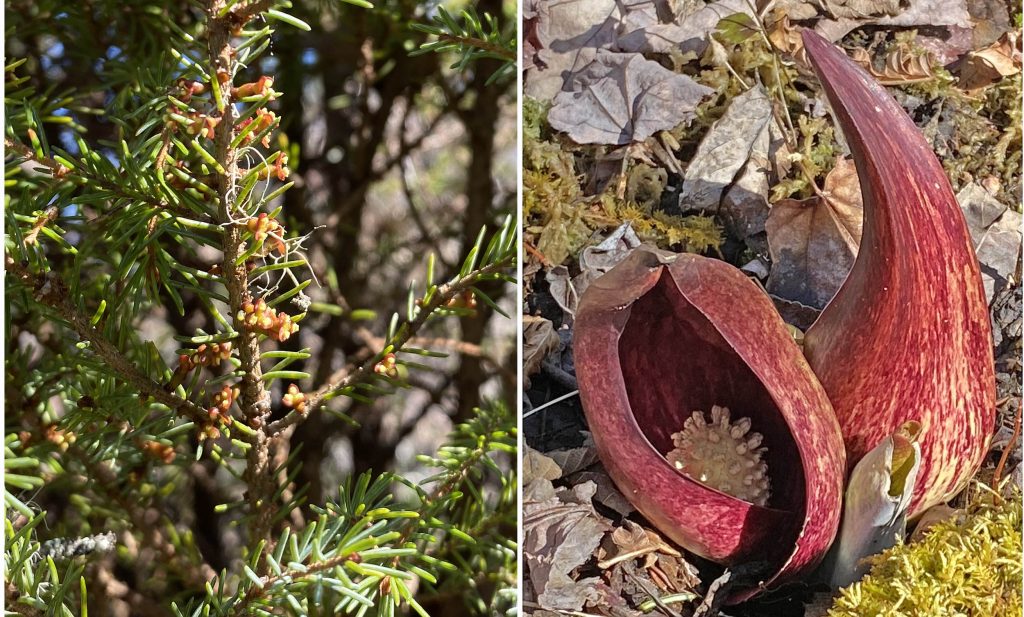In an effort to answer the question, Bob Guscott went to the one place where he could find the two candidates – Eastern Dwarf Mistletoe and Skunk Cabbage – close together

Eastern Dwarf Mistletoe (left) and Skunk cabbage (right) were both in flower on the Balancing Rock trail on March 30, 2021. Photos by Bob Guscott
Click on image for larger version
A year ago I asked in a post What’s the earliest flowering native plant in Nova Scotia?
From that post:
I thought the answer was skunk cabbage, Symplocarpus foetidus, which I thought is found naturally only in SW Nova Scotia but, according to Nova Scotia Plants, also occurs in Cumberland Co.
…I made a post about it on Facebook and soon got a message from Bob Guscott, retired forest pest specialist with DNR (now L&F), one of his obsessions being the ecology of mistletoe in NS…
Said Bob “The other candidate for first to flower in NS is Eastern Dwarf Mistletoe, Arceuthobium pusillum.
Evidently Bob was not satisfied to leave the question sitting there. Received from Bob today:
I wanted to send you an update on the flowing dates for 2 candidates for the earliest flowering NS native plant.
I started monitoring the flowering of Eastern Dwarf Mistletoe here in Wellington starting around March 20th. It was in full flower on March 25th. (Last year it flowered on March 28th)
Last year when we were on the trail to the Balancing Rock, on the Digby Neck, I noticed that both Skunk Cabbage and Eastern Dwarf Mistletoe were visible from the wooden boardwalk. Perhaps we could solve the mystery of what native plant is the earliest to flower.
So, last week (March 30th) we ventured down again to the Balancing Rock trail. It was a lovely warm sunny day and we had the trail to ourselves. Sure enough both plants were easy to find and literally growing within a few feet of each other. And both were in flower.
Alas, we did not solve the mystery and will have to schedule an earlier visit to Digby Neck next year.
Wow. That’s persistence.
———————————-
About Skunk Cabbage and Eastern Dwarf Mistletoe
Nova Scotia Plants on Skunk Cabbage:
Symplocarpus foetidus (L.) Salisb.
Skunk Cabbage; chou puantThe hooded spathe stands 10cm tall erupting through the snow in some years. Its disagreeable self is long-persistent. Leaves emerge about six weeks after flowering, and are very large, sometimes 1m in length. The venation is prominent.
Flowers in May.
Frequents riparian swamps, swales, bogs, sphagnous spuce woods and wet thickets.
Found in Digby and Yarmouth Co. and Cumberland Co. Scattered in the southwest though abundant where found. Ranges from NS to MB, south to TN, IA and NC; Asia.
Skunk cabbage is “thermogenic”, uncoupling its respiration from ATP (chemical) production to generate heat and melt holes in the snow and exposing the spadix (flower clusters). The heat also helps in sending out foul smelling volatiles to attract pollinators such as bluebottle fly – the adults feed on nectar, the females lay eggs on rotting flesh and so are attracted by the foul smells of skink cabbage.
Nova Scotia Plants on Eastern Dwarf Mistletoe:
Arceuthobium pusillum Peck
Eastern Dwarf Mistletoe; faux-gui nainA tiny shrub that parasitizes spruce trees, it buries its stems within the cambium of the host tree. Plants are brown or purple, the leaves reduced to scales. Flowers are borne on curved pedicels, each producing a single berry.
Flowers April to June.
Parasitic on the branches of spruce trees. Especially common in coastal black spruce forests. Along the Atlantic from Yarmouth to Cape Breton; common. Scattered inland and north along the Minas Basin to the Gulf of St. Lawrence.
Ranges from NF to SK, south to PA and MN.
Dwarf Eastern Mistletoe causes “Witches’ Broom” which may be more familiar than the flowers to most Nova Scotians. Bob Guscott comments further: ” It also occurs commonly in coastal old-field white spruce forests especially in Northern Nova Scotia. The other exciting aspect of the mistletoe life cycle is the mature seeds that swell in the fall and then explode under pressure and send tiny and sticky missile-like seeds through out the forest canopy. ”
View: USDA Leaflet for more about Eastern Spruce Dwarf Mistletoe.
